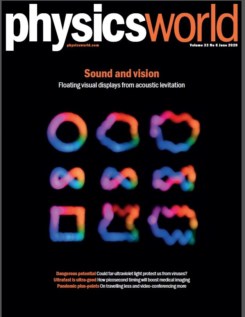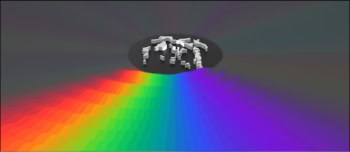The June 2020 issue of Physics World covers acoustically levitated displays, how far ultraviolet light could tackle viruses and working towards ultrafast imaging in medicine

Hovering 3D images are the stuff of science fiction. Just think of R2D2 projecting a message from Princess Leia in Star Wars, or perhaps Iron Man designing his latest tech in Marvel movies.
But in a Faraday cage at the University of Bristol in the UK, fiction is becoming reality with the help of some speakers and polystyrene balls.
As Michael Allen finds out in the cover feature of the June 2020 issue of Physics World, which is now out in print and digital formats, floating visual displays created using acoustically levitated particles could lead to galleries of singing heads, and even to advances in contactless manufacturing.
If you’re a member of the Institute of Physics, you can read the whole of Physics World magazine every month via our digital apps for iOS, Android and Web browsers. Let us know what you think about the issue on Twitter, Facebook or by e-mailing us at pwld@ioppublishing.org.
For the record, here’s a rundown of what else is in the issue.
• US students hit by extra demands – Graduate students under COVID-19 lockdown complain they are being unfairly asked to carry out more tasks such as online teaching, as Peter Gwynne reports
• From “techno-turkey” to iconic observatory – Launched in 1990, the Hubble Space Telescope has almost single-handedly transformed astronomical research and altered the public’s perception of space. Now, three decades on, attention is turning to its successor, as Keith Cooper reports
• From inflation to science policy – Katsuhiko Sato from the University of Tokyo talks to Graham Jones about his work on inflation and the future of physics in Japan
• Shock and awe – How do you react when something unexpected happens in physics? Robert P Crease runs through the gamut of emotions
• Kicking the habit – We all knew that we should have travelled less and video conferenced more. But with COVID-19, we have no other choice says James McKenzie
• Don’t press pause on innovation – Richard Bray says it’s as vital now as it was before the COVID-19 pandemic for physics-based firms to protect their innovation
• The potential of far-UV for the next pandemic – According to the physicist Charlie Ironside, our ability to deal with future deadly pandemics could be better – if we look to the far-ultraviolet. Jon Cartwright reports on a call to arms for the LED industry
• Making images with sound – Floating visual displays created using acoustically levitated particles could lead to galleries of singing heads, and advances in contactless manufacturing. Michael Allen investigates
• Imaginative intersection – Rachel Brazil reviews Entangle: Physics and the Artistic Imagination edited by Ariane Koek
• Explorer versus salesman – Ian Randall reviews Adventures of a Computational Explorer by Stephen Wolfram
• Safe training: the linac simulator – Marco Carlone, founder of Linax Technologies, talks to Tami Freeman about his motivation for creating an online learning tool that teaches medical physicists how to use and understand linear accelerators

Avoid, track, recycle: solutions to the problem of plastic waste
• Ask me anything – Sara Cruddas, space journalist, TV host, author and director
• From the lab to the courtroom – Sidney Perkowitz on crime-solving physicists Wilmer Souder and John H Fisher, who helped further the field of forensics with their research.



